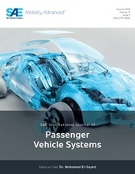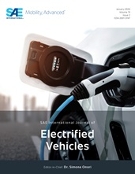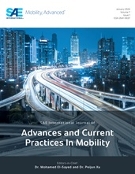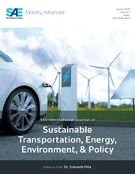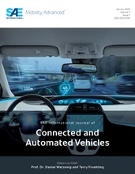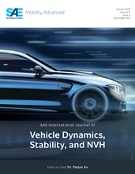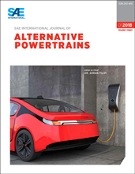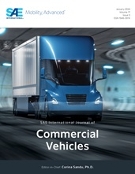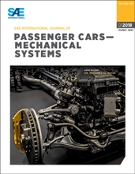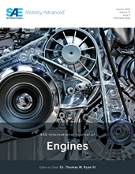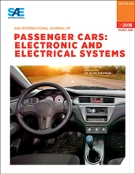Your Destination for Mobility Engineering Resources
Announcements for SAE Mobilus
Browse AllRecent SAE Edge™ Research Reports
Browse All 168Recently Published
Browse AllEaton’s Aerospace Group is collaborating with original equipment manufacturers (OEMs) on the advancement of technologies to increase aircraft efficiency, enable aircraft electrification, and reduce carbon emissions. Leveraging our expertise as an intelligent power management company, Eaton’s products and research include hydraulic power packs, electromechanical actuation (EMA), thermal management systems, and sustainable aviation fuel (SAF) compatible systems. Eaton Blended Power TM systems improve efficiency through eliminating all centralized hydraulic circuits with distributed power that is provided by a combination of hydraulic power packs and EMA for a More Electric Aircraft (MEA). EMA systems, including electrical synchronization, reduce the usage of hydraulics and provide additional functionality that benefits the aircraft. With MEA comes higher energy and thermal densities, resulting in the need for advanced thermal management. Eaton’s scalable and modular thermal management
Improvement and evolution of all aircraft technologies and the commercialization of new technologies are essential to the carbon-net-zero goal of air mobility. Passenger aircraft are required to provide the ultimate in comfort, economy, and safety, and gas turbine engines will not disappear, while promoting the conversion to SAF and hydrogen fuels. The More Electric Engine (or MEE) concept, which has been proposed since the late 2000s, is one alternative. This paper focuses on the electrification of engine accessories. When the concept of electrification of engine accessories was first presented at Aerotech 10 years ago, the discussion at Aerotech seemed to be negative. Attaching a motor to conventional engine accessories would obviously increase the weight. Next, the conventional engine accessories are centrally controlled and only FADEC is in command, but electrification of engine accessories will increase the cost by adding intelligence to all the accessories. On a more academic
This study presents empirical modifications of Blade Element Momentum Theory (BEMT) to improve rotor performance prediction for open rotors in hovering conditions. The empirical adjustments were made to the inflow ratio, factoring in the real rotor wake area and estimated induced power losses. A comparison between experimental data and two analytical models, one using an empirical inflow formula and the other a theoretical formula (classical BEMT), was conducted for two rotors. The empirical inflow model demonstrated superior accuracy in predicting thrust and torque. These modifications are applied to the inflow ratio by accounting for the actual rotor wake area and estimated induced power losses. The findings highlight the potential for more accurate performance prediction through the integration of empirical data into theoretical frameworks.
Climate-neutral aviation requires resource-efficient composite manufacturing technologies and solutions for the reuse of carbon fibers (CF). In this context, thermoplastic composites (TPC) can make a strong contribution. Thermoforming of TPC is an efficient and established process for aerospace components. Its efficiency could be further increased by integration of joining processes, which would otherwise be separate processes requiring additional time and equipment. In this work, an integrative two-step thermoforming process for hollow box structures is presented. The starting point are two organosheets, i.e. fiber-reinforced thermoplastic sheets. First, one of the organosheets, intended for the bottom skin of the uplift structure, is thermoformed. After cooling, the press opens, the organosheet remains in the press and an infrared heater is pivoted in, to locally heat up just the joining area. Meanwhile, a second organosheet, intended for the top skin, is heated and thermoformed and
Increasing digitalization of the aircraft cabin, driven by the need for improved operational efficiency and an enhanced passenger experience, has led to the development of data-driven services. In order to implement these services, information from different systems is often required, which leads to a multi-system architecture. When designing a network that interconnects these systems, it is important to consider the heterogeneous device and supplier landscape as well as variations in the network architecture resulting from airline customization or cabin upgrades. The novel ARINC 853 Cabin Secure Media-Independent Messaging (CSMIM) standard addresses this challenge by specifying a communication protocol that relies on a data model to encode provided and consumed information. This paper presents an approach to integrate CSMIM-specific communication concepts into a Model-Based Systems Engineering (MBSE) framework using the Systems Modeling Language (SysML). This enables a streamlined
The segment manipulator machine, a large custom-built apparatus, is used for assembling and disassembling heavy tooling, specifically carbon fiber forms. This complex yet slow-moving machine had been in service for nineteen years, with many control components becoming obsolete and difficult to replace. The customer engaged Electroimpact to upgrade the machine using the latest state-of-the-art controls, aiming to extend the system's operational life by at least another two decades. The program from the previous control system could not be reused, necessitating a complete overhaul.
